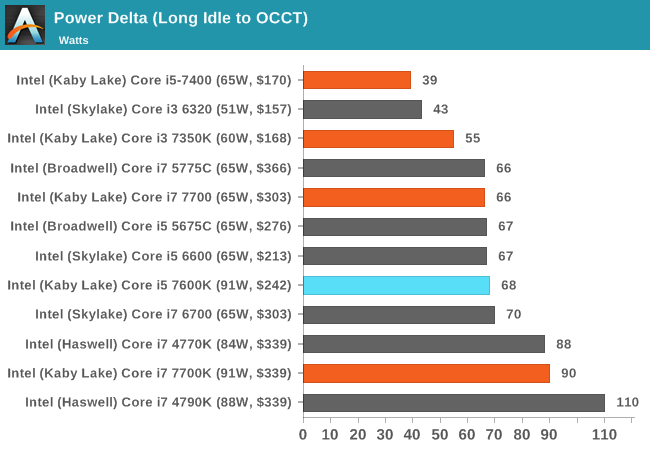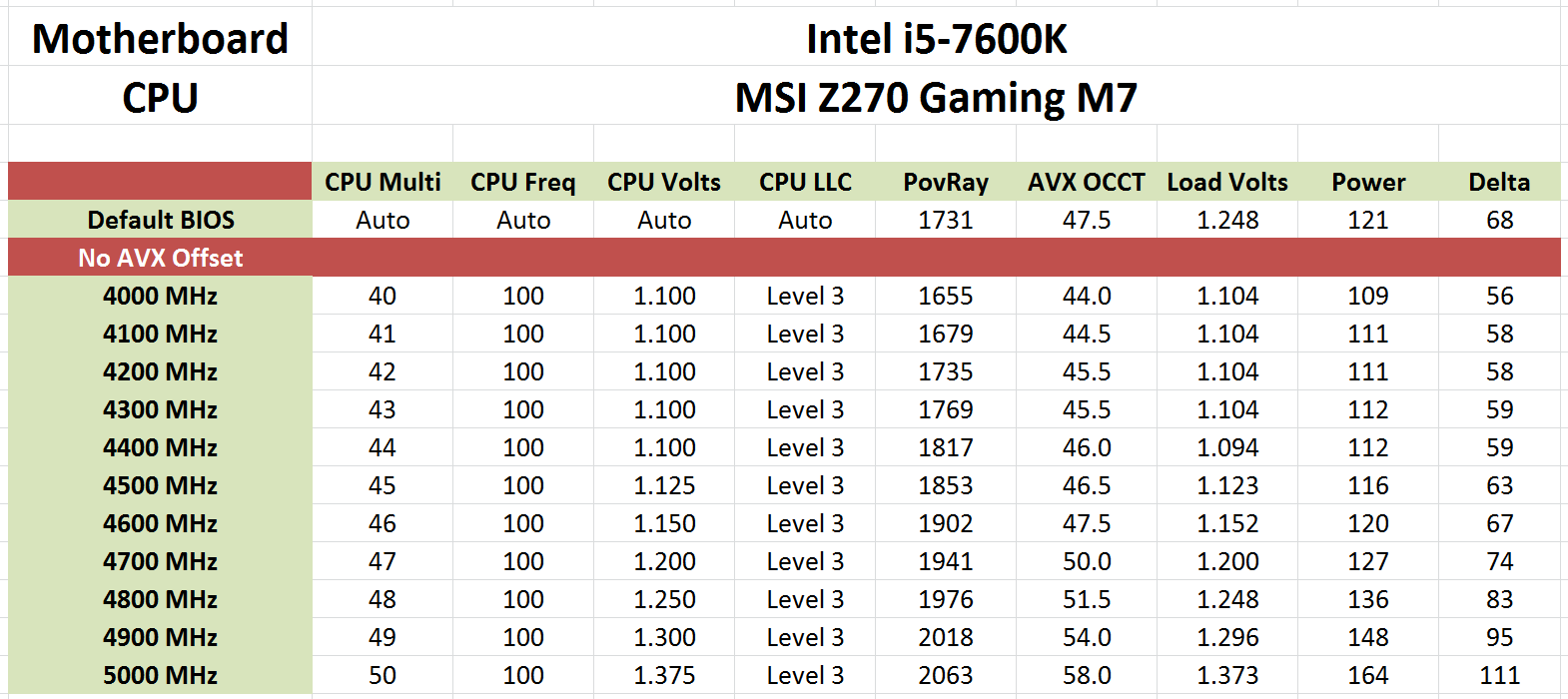The Intel Core i5-7600K (91W) Review: The More Amenable Mainstream Performer
by Ian Cutress on January 3, 2017 12:01 PM ESTPower Consumption
As with all the major processor launches in the past few years, performance is nothing without a good efficiency to go with it. Doing more work for less power is a design mantra across all semiconductor firms, and teaching silicon designers to build for power has been a tough job (they all want performance first, naturally). Of course there might be other tradeoffs, such as design complexity or die area, but no-one ever said designing a CPU through to silicon was easy. Most semiconductor companies that ship processors do so with a Thermal Design Power, which has caused some arguments recently based presentations broadcast about upcoming hardware.
Yes, technically the TDP rating is not the power draw. It’s a number given by the manufacturer to the OEM/system designer to ensure that the appropriate thermal cooling mechanism is employed: if you have a 65W TDP piece of silicon, the thermal solution must support at least 65W without going into heat soak. Both Intel and AMD also have different ways of rating TDP, either as a function of peak output running all the instructions at once, or as an indication of a ‘real-world peak’ rather than a power virus. This is a contentious issue, especially when I’m going to say that while TDP isn’t power, it’s still a pretty good metric of what you should expect to see in terms of power draw in prosumer style scenarios.
So for our power analysis, we do the following: in a system using one reasonable sized memory stick per channel at JEDEC specifications, a good cooler with a single fan, and a GTX 770 installed, we look at the long idle in-Windows power draw, and a mixed AVX power draw given by OCCT (a tool used for stability testing). The difference between the two, with a good power supply that is nice and efficient in the intended range (85%+ from 50W and up), we get a good qualitative comparison between processors. I say qualitative as these numbers aren’t absolute, as these are at-wall VA numbers based on power you are charged for, rather than consumption. I am working with our PSU reviewer, E.Fylladikatis, in order to find the best way to do the latter, especially when working at scale.
Nonetheless, here are our recent results for Kaby Lake at stock frequencies:

The Core i5-7600K, despite the 91W TDP rating, only achieved 63W in our power test. This is relatively interesting, suggesting that the Core i5 sits in a good power bracket for voltage (we see that with overclocking below), but also the mixed-AVX loading only starts piling on the power consumption when there are two hyperthreads going for those instructions at the same time per core. When there’s only one thread per core for AVX, there seems to be enough time for each of the AVX units to slow down and speed back up, reducing overall power consumption.
Overclocking
At this point I’ll assume that as an AnandTech reader, you are au fait with the core concepts of overclocking, the reason why people do it, and potentially how to do it yourself. The core enthusiast community always loves something for nothing, so Intel has put its high-end SKUs up as unlocked for people to play with. As a result, we still see a lot of users running a Sandy Bridge i7-2600K heavily overclocked for a daily system, as the performance they get from it is still highly competitive.
There’s also a new feature worth mentioning before we get into the meat: AVX Offset. We go into this more in our bigger overclocking piece, but the crux is that AVX instructions are power hungry and hurt stability when overclocked. The new Kaby Lake processors come with BIOS options to implement an offset for these instructions in the form of a negative multiplier. As a result, a user can stick on a high main overclock with a reduced AVX frequency for when the odd instruction comes along that would have previously caused the system to crash.
We used the AVX Offset option when we overclocking the Core i7-7700K and achieved another 100-200 MHz extra frequency for non-AVX before succumbing to overheating. Ultimately that’s not a lot of frequency, but that can be enough for some users. With the Core i5-7600K, we got a great result without even touching the AVX offset option:
Straight out of the box, our retail sample achieved an OCCT stable 5.0 GHz with mixed AVX at a 1.375V setting, with the software recording only 58C peak on the core and a maximum power draw of 111W. That’s fairly astonishing – from the base 3.8/4.2 GHz we were able to get up to 800 MHz in an overclock for just under double the power draw (or, +20W over TDP).











70 Comments
View All Comments
solnyshok - Wednesday, January 4, 2017 - link
7350K seems like a good old overcloking fun CPU. Introduced just ahead of Ryzen launch. Taking this one from 4.2 to 5GHz is a good +20% overclock. And good (not incredible) value at $175. This or its successor on 10nm will be my next gaming machine.skpetic - Wednesday, January 4, 2017 - link
1. Aggregated results are that an i7-6700 is as fast as the i5-7600K(?)2. The 6700 is more future proof as it has better performance in applications with good multithreading implementations (future apps and games)
3. Why is this not considered in the review?
Anato - Wednesday, January 4, 2017 - link
Had I known this in 2011 when I bought i5-2500k I would have purchased i7-2600k for hyperthreading as it helps in spice simulations. I also would have spend 100$ more to better modo. On the other hand I saved 200$+interest not doing so...I'm almost happy that advancement in performance has slowed down. No need to upgrade and finally we are seeing software being optimized. Like Chrome browser, we wouldn't see these java script competitions if never hardware would be suffice.
masouth - Wednesday, January 4, 2017 - link
In the 5th paragraph you have the 7600K as 4.0 base/ 4.2 turbo but in the table it is listed as 3.8 base/ 4.2 turbopavag - Wednesday, January 4, 2017 - link
I cannot find the log out linkzodiacfml - Thursday, January 5, 2017 - link
Not surprised.inmytaxi - Friday, January 6, 2017 - link
Why is the ivy bridge you are using the 3770k, an i7, instead of an i5 3570k? Don't you think people considering the i5 are more likely to have ... AN IFIVE@!!!!Adam Saint - Saturday, January 7, 2017 - link
Looks like the 4790k is holding up exceptionally well in both single and multithreaded tests. Impressive for a chip that's 3 generations old.epobirs - Sunday, January 15, 2017 - link
I build new systems as a hobby, so I'm not especially concerned with whether the new box is a sufficient upgrade over my current main system. That my next build can have some incremental improvements at about the same price point is real progress in my book. Right now, I have a pair of Antec mITX cases I got especially cheap. The original purpose they were intended to serve has been cancelled, so some HTPC configurations are likely, just for the fun of it. since some of Kaby Lakes upgrades are directly applicable to an HTPC's needs, those are likely the parts I'll use if no Skylake items become available for an especially good price.In general, incremental upgrades of the product line don't offend me any more than minor improvements to an automobile model from one year to the next. Just because I'm not in the market for a new car this year doesn't mean they should hold still. There are plenty of others who are more than due for an upgrade and those incremental improvements add up eventually for everybody.
snapch23 - Friday, December 29, 2017 - link
It is good that we know so much of the gta. http://mygtacheats.com